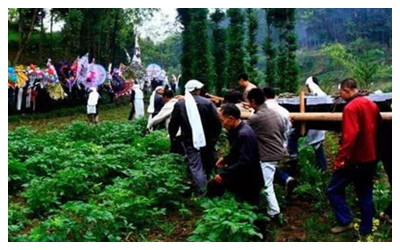
Chinese Funeral Customs
 In China, preparations for the funeral start when a person is gravely ill. First, a family orders traditional coffin. The shape of such a coffin is rectangular with three "humps". It has to be mentioned that nowadays western style coffins are becoming more popular.
In China, preparations for the funeral start when a person is gravely ill. First, a family orders traditional coffin. The shape of such a coffin is rectangular with three "humps". It has to be mentioned that nowadays western style coffins are becoming more popular.
If the deceased is a father his eldest son is becoming a head of the family. And in case the eldest son dies his role is taken by the second son of the family. His duties among others include relations with the family ancestors.
There is one more detail. If the deceased is a man people put a gong to the left of the entrance. And if the deceased is a woman a gong is put on the right side.
Body of the deceased is cleaned with a damp towel with some talcum powder applied on it. Then the deceased is dressed in the finest clothes. Such clothes are usually white, black, blue or brown. Only one colour is forbidden. It is red. Why? Chinese believe that if the deceased would be dressed in red he/she will be become a ghost. All other clothes that the deceased used to wear when he/she was alive are burned.
Then the face of the deceased is covered with a yellow cloth. The body is covered with a light blue cloth. After that the body is put in the coffin.
If the deceased died at home the coffin will also be there. But, if he/she died out of home than the coffin will be placed in the courtyard. There are rules considering the position of the coffin. The coffin is put on two stools with a head of the deceased positioned towards the house.
Traditionally, people do not wear jewellery that includes red objects, children and grandchildren of the deceased would not cut their hair for 49 days after the death. This tradition is not so common anymore.
Family members gather around the coffin. Here persons are positioned according to rules. The colour of clothes worn is also very important. Children and daughters-in-law wear black. Black symbolized the strongest sadness. Grandchildren wear blue clothes and grand grandchildren, if there are any, wear light blue clothes. Sons-in-law wear white or of similar colour. The children and daughters-in-law of the deceased will also wear a sackcloth hood on their head.
The eldest son is suppose to sit at the left shoulder of his parent's coffin and the spouse of the deceased sits on the right. Traditionally those relatives who arrive later are crawling on their knees towards the coffin.
At the foot of the coffin the family prepares an altar. A burning incense and lit white candle are put on such an altar. The Chinese believe that the deceased should have kind of income during his afterlife. That is why during the wake people burn joss paper.
Everyone present at the wake burns an incense and bows as a sign of respect for the deceased. Then they took turns standing by the casket. When the family started to cry for the loss of a family member, eight men and women with drums on their waists, led by a man with a wooden dragon head in his hand, started to dance to the beat of the drums in vigorous steps. When the music stopped, the dancers started to walk slowly, singing a mourning song.
According to the Han custom, a mourning ceremony includes paying respects to the deceased, gift-giving and a banquet given by the family of the deceased to express their thanks to friends and relatives.
The guests attending the mourning ceremony will take turns to sing and dance all through the night. When the funeral procession is held on the following morning, the family members of the deceased will walk in front, holding the mourning streamer. The younger generation in the family are required to kneel down, letting the casket pass overhead. On the way, people will stop after walking every hundred meters to sing and dance around the casket until it is buried in the mountain.
Chinese funeral has several main traditions. There are Buddhist ceremonies that last at least for 49 days. First 7 days are believed to be the most important. Prayers are said every 7 days for 49 days. If a family of the deceased is poor this period can be short, lasting for only 3 days.
Traditionally the daughters of the deceased pay the funeral costs. The head of the family should at least be present at first prayer ceremony, if possible at second prayer ceremony and certainly at the burial or cremation.
Chinese also have a special prayer ceremony held every 10 days. This ceremony includes the Buddhist ceremony and 3 succeeding periods of ten days until the burial or cremation.
A final ceremony may be organized 100 days after death. But, for most Chinese it is not so important. The age of the deceased, the cause of death, the fact that the deceased was single or married, the social status of the deceased are all factors that influence Chinese death rites. The whole procedure of the funeral and everything around should be done in a proper way. Any irregularities can cause bad luck and accidents in the family of the deceased.







 Ask Questions ?
Ask Questions ?